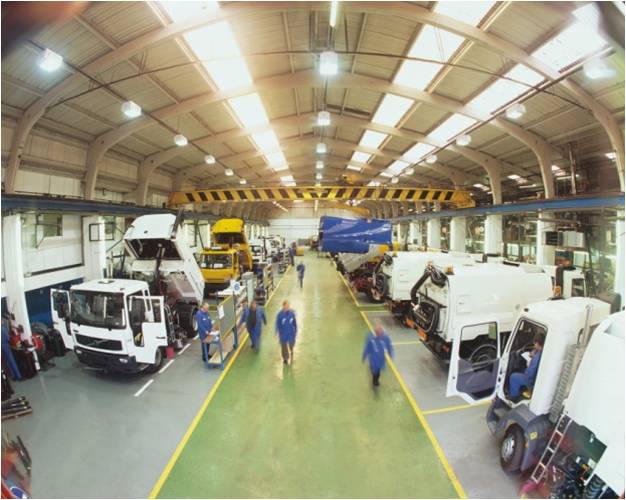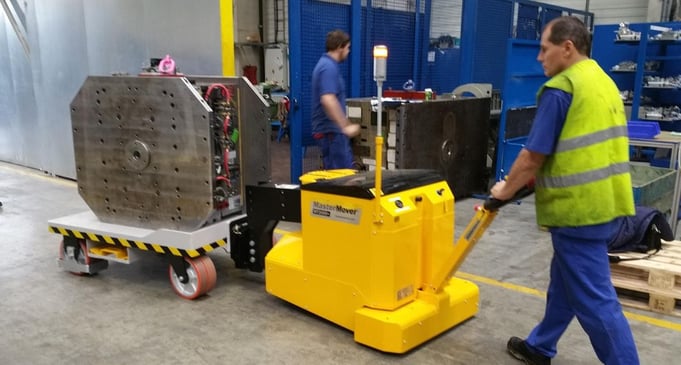Tow Tugs Help Johnston Sweepers Realise Multiple Efficiencies

Following the purchase of two pedestrian operated tugs, a manufacturer of road sweepers has not only reduced manufacturing waiting times across two of its UK factories, but has also seen improved production flows and labour efficiencies, as well as eliminating the risk of accidents and injuries to employees. The tugs have also played a key role in supporting the introduction of new Lean Manufacturing and Continuous Improvement principles across the two manufacturing plants.
Established in 1904, Johnston Sweepers is a world-leading manufacturer of outdoor surface cleansing equipment. With two manufacturing plants in the UK and more than 200 distributors worldwide, the company is a major global business. Cleansing equipment from Johnston Sweepers can be seen in a variety of applications, including shopping malls, city streets, pedestrian precincts, new roads, building sites and major international airports.
The UK production sites manufacture a range of municipal and contractor cleansing vehicles, from 4 tonne vehicles up to chassis-mounted units in excess of 18 tonnes. The Ash Vale plant near Aldershot manufactures sweeper bodies. Tim Royle, Production Services Co-ordinator at Dorking comments: “The factory is relatively small and space is tight. Part of the manufacturing process here is to fettle the sweeper body and then apply bitumen to the water tank, which is situated on the underside of the sweeper body. To do this, we designed a special purpose trolley that sits on castor wheels. This enables a complete sweeper body to sit in a cradle arrangement. The body weighs in excess of one tonne, but the trolley-cradle system allows us to move the body between processes and to fettle and bitumen the body before it is painted.”
Prior to investing in two MasterMover MT5 tugs, between two and four people were required to move the trolley. This meant one person would have to interrupt other people from doing their job in order to help move the trolley. “I suppose we’d been moving the sweeper bodies in this way for many years, so we got used to doing it that way. Moving the trolley was like having to negotiate an obstacle course with narrow aisles and tight bends. It was a real struggle and was very time consuming,” he recalls.
“However, in 2009 we invested in two MT5 tugs. Now, it requires only one person to move the trolley, which can be manoeuvred in and out of very tight spaces and around bends easily.”
The MT5 can pull, push and steer wheeled loads up to 4,000 kg, which is sufficient to move the trolley and sweeper body. Traction is the key to moving heavy loads and so the MT5 is designed to get all the traction it requires by using a coupling system to transfer load weight to the drive wheel.
As well as being a low maintenance handling solution, the speed and performance of the tug can be specified by the customer. The tug is also able to rotate through 90 degrees either side of the payload, allowing the conveyance to turn on its axis. Secondary electromagnetic braking and emergency stop features are also provided.
Johnston Sweepers’ other UK manufacturing site is in Dorking, Surrey. The finished sweeper bodies from Ash Vale are transferred to Dorking, where they are shot blasted and painted.
The paint shop at Dorking is a state of the art facility that was installed in 2005. The sweeper bodies require shot blasting prior to painting and so are moved using a similar (but slightly smaller) trolley and cradle arrangement to the one at Ash Vale. However, in order to move the trolley from shot blasting to the paint booths, the trolley has to negotiate a slope and an awkward 90-degree turn.
Tim Royle explains further: “Again, moving the trolley required two to four people, who had to be removed from important tasks to help out. The slope and tight corner were causing problems, not just in how long it took to move the trolley from shot blasting to painting, but also in terms of the risks to the people moving the trolley up and down the slope and round the tight bends. We decided that the risk of an accident occurring or an injury to an employee was too high and so in 2008 we started looking for a suitable solution.”
Tim Royle says that he tried to find three suitable suppliers but only found two that could offer a solution. “One of these suppliers came to Dorking to show us their machine, but it failed miserably. The other supplier, MasterMover, also visited the factory to demonstrate its recommended solution, the MT5,” he continues.
Following a demonstration of the MT5, Tim Royle says he was convinced that the tug would solve the problems at Dorking. Now, only one person is required to move the trolley up and down the slope from shot blasting to the paint shop. This person no longer needs to disturb other workers from getting on with their skilled jobs.”
At Dorking and Ash Vale, there is now less waiting time between jobs and production flows have improved. “The MT5 has really taken away the hassle from moving the sweeper bodies between the different stages of manufacturing. The employees enjoy using the tug and find it very easy to control. Initially, MasterMover trained four people to use the MT5. These four were then able to train another four workers on their own. Around 10 people are now trained to use the MT5 so that we have cover across both day shifts at both sites,” he adds.
As the two MT5s are deemed critical to operations at Johnston Sweepers, the company signed a maintenance agreement with MasterMover, whereby the tugs are serviced and maintained at regular intervals.
“Since we invested in the tugs, there has been no resistance to using them from the employees and there have been no issues at all with regard to performance of the tugs. In fact, I wonder how we ever managed to move the trolley before!” he exclaims.
But there is one other important factor that has made the tugs a critical part of operations at both Ash Vale and Dorking. As Tim Royle states: “Recently, we have adopted Lean Manufacturing and Continuous Improvement practices throughout the two sites. This means that reducing waiting times between jobs must be minimised. Labour resources cannot be wasted on non- value-added activities and the manufacturing flow must be improved. This is another area where the tugs have helped improve our operations.”


